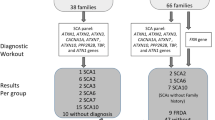ABSTRACT
Friedreich ataxia (FRDA) is the most common form of autosomal recessive ataxia. The disease locus was assigned to chromosome 9 and the disease gene, STM7/X25, has been isolated. To date most data suggest locus homogeneity in FRDA. We now provide strong evidence of a second FRDA locus. Studying two siblings with FRDA from two families we did not detect a mutation in STM7/X25. Haplotype analysis of the STM7/X25 region of chromosome 9 demonstrated that the relevant portion of chromosome 9 differs in the patients. Although the patients studied had typical FRDA, one sibpair had the uncommon symptom of retained tendon reflexes. In order to investigate whether retained tendon reflexes are characteristic of FRDA caused by the second locus, FRDA2, we studied an unrelated FRDA patient with retained tendon reflexes. The observation of typical mutations in STM7/X25 (GAA exopansions) in this patient demonstrates that the two genetically different forms of FRDA cannot be distinguished clinically.
Similar content being viewed by others
Author information
Authors and Affiliations
Additional information
Received December 19, 1996; Revised and Accepted January 22, 1997
Rights and permissions
About this article
Cite this article
Kostrzewa, M., Klockgether, T., Damian, M. et al. Locus heterogeneity in Friedreich ataxia. Neurogenetics 1, 43–47 (1997). https://doi.org/10.1007/s100480050007
Issue Date:
DOI: https://doi.org/10.1007/s100480050007




